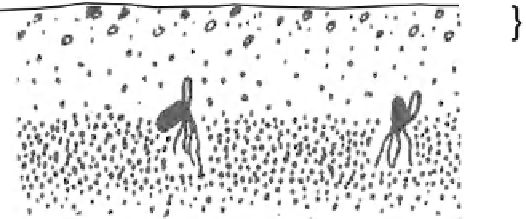Agriculture Reference
In-Depth Information
top surface
zone of coarse particles
zone of loose soil
zone of recompacted soil
.
.
,
.
.
.
depth of second. cultivation
Fig. 7.11
Fractionated seedbed for the prevention of crust formation on the top surface by some
coarse soil particles (vertical cross-section)
cultivation is not uniform in the vertical direction. So for these cases, soil size reduction
within the seedbed should be controlled not only in the horizontal direction, but in
the vertical direction as well.
The soil particles that have direct contact with the seeds always should be fi ne in
order to ensure water transfer. Possibly immediately underneath the seeds, the soil
should be denser than above them. This helps to draw some water from below in a
dry spell. Loose soil above the seeds provides for the aeration needed. And if sur-
face crusting might develop, there should be coarser soil particles on or near the
surface to prevent this. So a
fractionated seedbed
(Fig.
7.11
) would be needed
(Heege and Vosshenrich
1998
,
2000
; Heinonen
1985
; Hakansson et al.
2002
; Satkus
and Velykis
2008
).
Up to now, no farm machines are available that allow precisely to adjust the
degree of fractionation. But at least the seedbed could tend to be structured as out-
lined above. To a small extent, the more dense soil immediately underneath the
seeds is created by the pressure of the seed openers. And some vertical fractionation
of soil particles can be obtained by segregating small soil particles from larger ones
during secondary cultivation. While the soil is stirred, small particles have a better
chance than the larger ones to sift downwards in voids,
e.g.
behind tines. As a result,
more large aggregates remain near the surface.
This
segregation by sifting
needs rather slow moving tools, such as the tines of
drawn implements. With fast moving tines, such as those of power-take-off driven
implements, no segregation occurred (Heege and Vosshenrich
2000
). Probably this
can be explained by the time that is needed for small particles to sift downwards in
voids behind tines. With fast moving tines, this time is too short for a remarkable
segregation to take place.
The fractionation depends on the
rake angle
of the tines (Fig.
7.7
, left). A low
rake angle and therefore tines pointed forward in the direction of travel improve the









